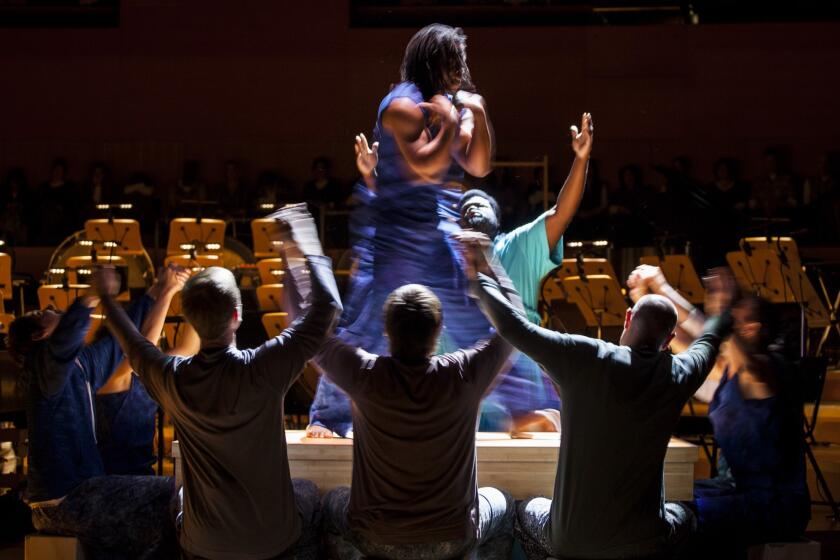Review: Beethoven’s Fifth is the music of our moment. How Teodor Currentzis makes it so

“He has … the power to make you feel at the finish: Something is right in the world.”
That’s Leonard Bernstein on Beethoven during a segment of CBS’ 1950s series “Omnibus.” These days, many people have been turning to Beethoven since the coronavirus crisis made us feel that something is clearly wrong in the world. Can Beethoven help?
The Fifth Symphony wants to. It’s ta-ta-ta-TAH opening announces the four best known symphonic notes in the world. Whether or not Beethoven meant them to represent fate knocking on the door, as unreliable legend has it, we who are so suddenly and unexpectedly living behind closed doors can certainly identify with the feeling.
Furthermore, whatever those three brusque Gs followed by a long, heavy E are up to, they shake you up. They suffuse the atmosphere of all that follows for the next half-hour and lead inexorably, as no other single piece of music has been able to equal, to triumph. With the Fifth, Beethoven invented the victory symphony, and everyone has understandably wanted a piece of that.
In 1943, Wilhelm Fürtwängler, reputed to be the greatest Beethoven conductor of all time, gave a performance of herculean monumentality in Berlin, signaling, if nothing else, the invincibility of German culture. A few months later, Arturo Toscanini conducted the Fifth at Carnegie Hall to promote U.S. war bonds. It was so stirring that it raised $6.5 million, the equivalent of nearly $10 billion today. This was a streamlined performance, lightning fast, crackling with electricity — it too the sound of victory at hand.
In December, we will celebrate the 250th anniversary of Beethoven’s birth, and added to the hundreds of recordings of the symphony have been at least two dozen new releases this year. One stands out, big time: that by Greek-born conductor Teodor Currentzis and his ensemble, Musica Aeterna. It was released in digital form by Sony Classical this month. A CD will follow in May, and, if we are lucky, so will a vinyl version.
Although recorded in 2018 and its release date planned long ago, the timing couldn’t be more timely. Unlike other modern recordings of the symphony, this really is a recording of the Fifth, not a document of a live performance. It reminds us of what we can, for the moment, experience only virtually. Following in the footsteps of Leopold Stokowski and Glenn Gould, Currentzis is one of the very few great classical artists who treats recording as an art form in its own right.
Make no mistake, the conductor is a showman who relishes live performance. He has a chorus of detractors who complain about his wildly emotional style, his haircut and his super-tight jeans. His ensemble, jointly based in Russia and Germany, performs on period instruments and plays standing up, every single musician bringing something individual. They rehearse day and night with cult-like devotion to Currentzis, who has grand spiritual ideas about all he does. His goal, one I’ve witnessed being achieved every time I’ve been at one of his concerts, is to achieve catharsis.
Passover and Easter inspired some of the most spiritually profound music. Why it’s time to hear these works by Bach, Wagner, Schoenberg and Adams.
What makes this so meaningful as we attempt to maneuver our lives in the coronavirus pandemic, as we reconsider the entire notion of normality, is that Currentzis has always treated normal as his nemesis, and so did Beethoven. So rather than attempting to re-create the live performance, he makes recordings meant to provide a concentrated personal experience as opposed to a communal one. Balances, nuances, the blushing delicacy colors of these early instruments played with phenomenal skill are revealed as they never could be in the concert hall.
In the Fifth, Beethoven used an orchestra more boldly than ever before. The brass are far more brash. The timpani take command, as drums never had before in any music outside the military. The first audience had never heard any indoor sound that loud.
The symphony has a relentless rhythmic power. That full force of Beethovenian will, along with his sheer sonic force, conveying the feeling of something right in the world, proved too much for some. At the premiere, those against musical or any other kind of revolution reportedly freaked out.
Currentzis doesn’t hit the listener over the head with his performance, and that’s welcome during a pandemic, but he does insist that there is something of immense importance that must be attended to. Fate here needn’t bother to knock — it brushes in like a breeze.
For Currentzis, ta-ta-ta-TAH is a launching pad. While he follows Beethoven’s very fast original tempos closely, this performance doesn’t feel fast. Instead, the details — Currentzis mixes laboriously in such a way that headphones provide optimal listening — are so incredibly rich that time feels like it is slowing down. In the most fleeting of notes, you might hear a tiny expressive swell that implies, like the twitch of a single leg of a centipede, that this is a living entity we are attending to.
There is beauty, extreme in its glitter and glow, to be found in the utter delicacy and effusiveness of the slow movement. And there is ugliness. A perturbed early 19th century Russian reviewer described the spookiest passage in the symphony, which leads to the triumphant Finale, as “odious meowing.” Hands guiding the orchestra, hands at the dials in the editing room, Currentzis here lets the cat out of the bag.
Peter Sellars — opera director, spiritual thinker, optimist — reflects on changes triggered by coronavirus. Amid tragedy, what new life might come forth?
For thrills and virtuosity, check out the seismic reverberations of the double basses taking up the charge in the trio section of the scherzo at the bottom of the sonic spectrum. Currentzis also makes damn well sure that you won’t be prepared for the revolution Beethoven lets loose at the end of the symphony.
For our part, we are damn well sure that all is not right in the world. But here is something that is. And that’s one meaning of hope.
More to Read
The biggest entertainment stories
Get our big stories about Hollywood, film, television, music, arts, culture and more right in your inbox as soon as they publish.
You may occasionally receive promotional content from the Los Angeles Times.













